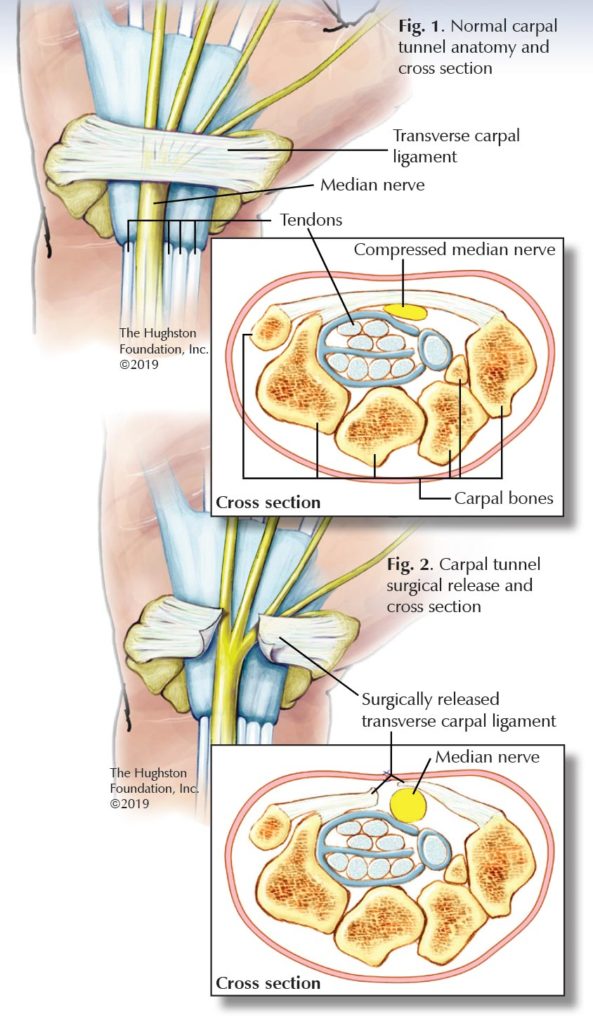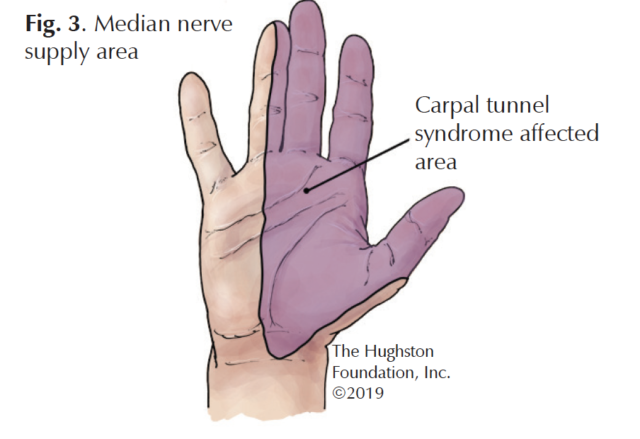
Have you awaken from sleep with numbness, burning, or “pins and needles” sensations in your hands? Have you noticed that your sense of touch or your grip is weakening and that you are dropping items often? Are you having pain or difficulty with fine motors skills, such as writing, fastening buttons, or sewing? If you answered yes to any of these questions, you may have carpal tunnel syndrome.

What is carpal tunnel syndrome?
Carpal tunnel syndrome is an entrapment neuropathy, which means that the nerve is compressed or pinched to the point that it disrupts the normal electrical signals. When the median nerve at the wrist is under pressure and irritated, it creates symptoms of pain, numbness, or weakness usually in the hand and fingers. Common activities, such as talking on the phone, holding a book, or driving tend to bring on the symptoms. Carpal tunnel is a progressive condition, which if left untreated can lead to permanent nerve damage.
Carpal tunnel anatomy
The median nerve passes through a compact, firm tunnel on the palm side of your wrist. The top of the carpal tunnel is formed by the transverse carpal ligament (a band of fibrous connective tissue that connects bones), and the sides and bottom are made up of 8 small carpal (wrist) bones. The carpal tunnel has 9 tendons (soft tissue that connects muscle to bones)—2 for each finger and 1 for the thumb—that pass through the carpal tunnel alongside the median nerve (Fig.1).

What are the signs and symptoms?
Repetitive wrist movements involving flexion (bending) and extension (straightening) of either the wrist or fingers may result in inflammation throughout the wrist’s architecture. When inflammation or swelling within the carpal tunnel compresses the median nerve, symptoms of paresthesia (tingling, pricking, numbness, burning) or loss of feeling in the first, second, third, and part of the fourth finger occurs (Fig.3). The little finger sensation is usually not affected. The nerve signal to the thumb muscles lessens overtime and dropping items frequently occurs.
Other symptoms of carpal tunnel syndrome include tingling and pain that radiates up the length of the arm toward the shoulder. During sleep when the elbow or wrist are in a bent position, the hand and wrist pain can awaken you. If your condition is advanced, you can permanently lose strength and feeling in your hand and fingers.
Who is at risk?
Any repetitive movement in the hand and wrist can cause carpal tunnel syndrome and it can be triggered by other medical conditions as well. The risk is not confined to any 1 type of job or industry, although people sometimes relate it to computer usage. Many conditions can cause pressure to build up in the carpal tunnel and impinge the median nerve. For example, people with diabetes who experience neurological symptoms and women who experience fluid buildup during pregnancy are at a higher risk.
The carpal tunnel is relatively smaller in females than in males, which may account for an increased incidence of the condition in women. Sometimes only 1 hand is involved, but both hands are affected in about 50% of patients. Unfortunately, the exact cause of carpal tunnel syndrome cannot be accurately determined in most cases.
When should I seek medical advice?
If you have any type of tingling or loss of sensation in the wrist, hand, or forearm you should seek the attention of an orthopedist who specializes in the hand and wrist for diagnosis. Early diagnosis for carpal tunnel syndrome is important to avoid permanent damage to your median nerve.
How is carpal tunnel syndrome diagnosed?
To diagnose carpal tunnel syndrome, your orthopedist will ask about your symptoms and perform an examination of your hand, wrist, arm, and neck. During the exam, your physician will try to reproduce your symptoms to help diagnose the problem. After taking a detailed health history and performing a physical exam, most physicians can accurately diagnose the condition; however, special testing of the nerve can aid in diagnosis. Electrodiagnostic testing can be performed to determine which nerve(s) are involved, where it is, and the severity. Two specific tests that can be performed to determine whether you are suffering from carpal tunnel syndrome are Tinel’s sign (named after French neurologist Jules Tinel, 1879-1952) and Phalen’s test (developed by American orthopedist George S. Phalen, 1911-1998). Both tests put increased pressure on the structures running through the tunnel in order to verify whether or not the pain is produced in these positions. Your orthopedist can also conduct various tests to rule out differential diagnosis, such as a scaphoid fracture, rheumatoid arthritis, or other inflammatory diseases that can affect your wrist joint.
What are the first steps my doctor will take?
Treatment for carpal tunnel syndrome can be as simple as changing a person’s routine or positioning during various activities. Upon initial diagnosis, your physician may suggest a change in posture or limiting time spent in various positions that put pressure on the structures involved. If related to hand use, you may be instructed to take more frequent breaks during repetitive tasks or, if possible, stopping activities that causes the symptoms. Splint use at bedtime is usually the first course of treatment if your symptoms mainly affect you overnight. Nonsteroidal anti-inflammatory drugs (NSAIDs), such as naproxen or ibuprofen, may alleviate pain and symptoms of early carpal tunnel syndrome. However, they have potential side effects with long-term use. If these measures do not prove helpful, surgery may be the answer.
What will the surgery be like?
Carpal tunnel surgery is usually performed as an outpatient procedure. You can often choose to have just local anesthesia or to be put to sleep. The surgery can be done with a traditional open incision on the palm, or a less invasive endoscopic technique. Endoscopy is a newer, less invasive method that uses a special video camera to view inside the hand. With a 1 to 2cm (less than 1/2 inch) incision on the wrist, the endoscope camera enters the carpal tunnel. Under direct visualization, a small blade on the scope releases the transverse carpal ligament compressing the nerve (Fig. 2). Endoscopy versus an open technique has higher patient satisfaction and recent studies show fewer complications after endoscopic surgery.
Is recovery faster with endoscopic surgery?
With endoscopic surgery, you will only have 1 or 2 stitches on the inside of your wrist compared with 4 to 8 stitches on the palm during traditional open surgery. The endoscopic recovery is faster and you gain function sooner because the traditional incision on the palm is painful, and limits hand use for 3 to 4 weeks. After an endoscopic procedure, you can immediately begin light activities, such as eating or getting dressed the day of surgery, and most patients can drive a car the next day.
What’s the long-term prognosis?
In most patients, the tingling and pain of carpal tunnel syndrome usually vanishes quickly after surgery. For more advanced disease, the nerve healing after surgery can take weeks. In the most severe cases, involving permanent nerve damage, complete resolution of symptoms is uncommon. Overall, carpal tunnel release surgery has very high patient satisfaction rate.
How can I prevent carpal tunnel syndrome from ever happening?
Basic prevention for carpal tunnel syndrome requires proper posture and body mechanics; this may include office ergonomics—that is, proper biomechanics for those who sit at a desk and use a computer or less time using motorized tools. When doing work that uses the hands and wrist, you should reduce the force of movements and relax your grip; stretching and taking frequent breaks are also essential. Additionally, it will help if you maintain a healthy weight, exercise, avoid smoking, and control any other medical conditions you may have such as diabetes.
Final recommendations
If left untreated, carpal tunnel syndrome can become disabling. It can cause irreversible damage to the median nerve, which can lead to problems with everyday activities such as picking up objects and holding them. See an orthopedists before your symptoms become unbearable or nerve damage occurs. If you seek help early enough, you may find relief nonsurgically; however, if you do need surgery, the procedure is effective at relieving your symptoms.
Author: Pasquale F. Reino, DO | Kissimmee, Florida
Last edited on October 15, 2025